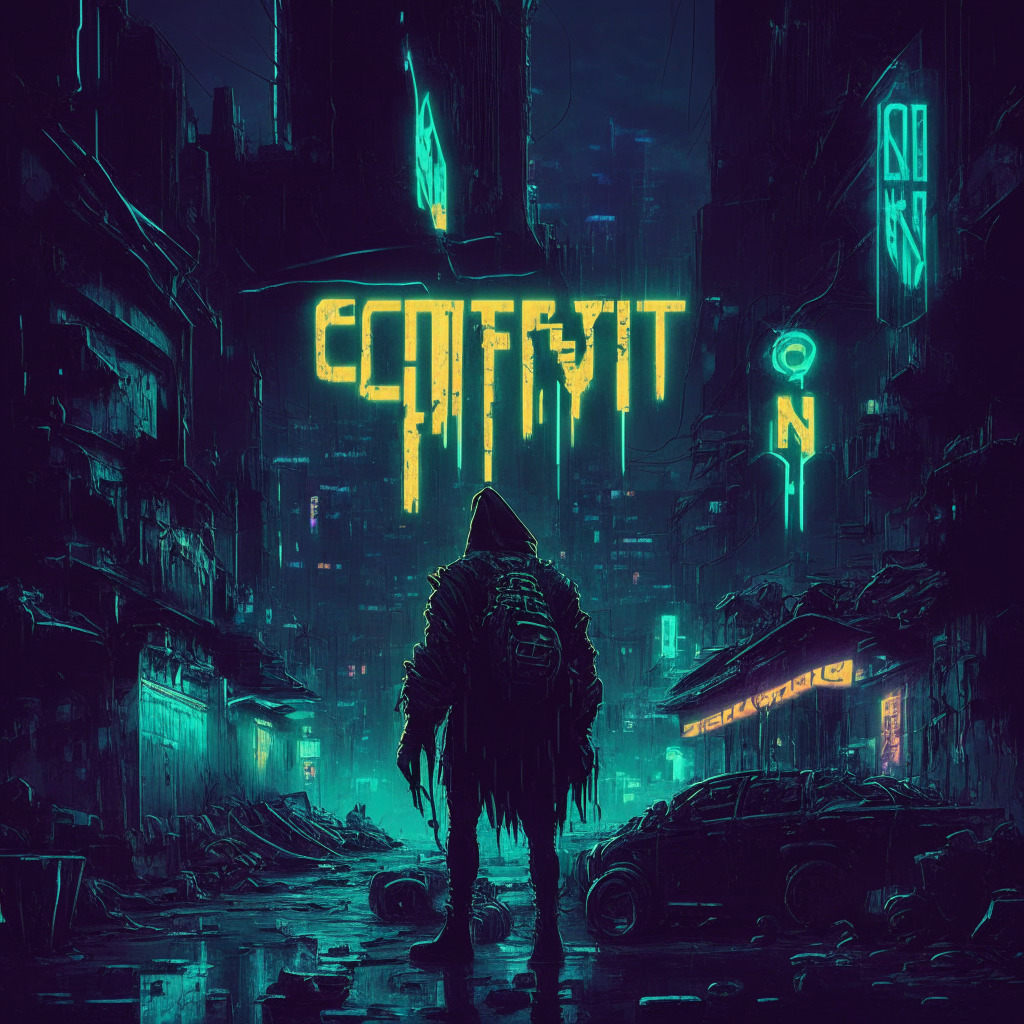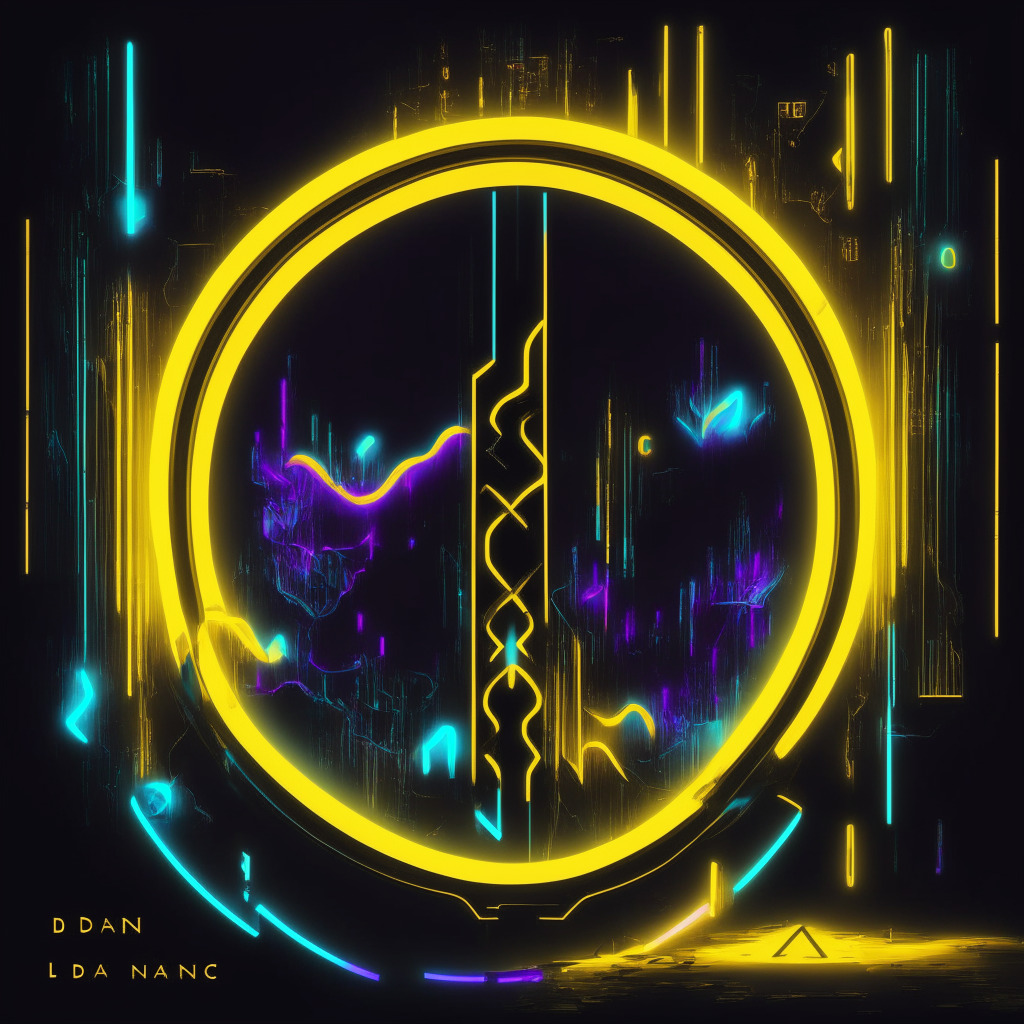“The DeFi market endured significant upheaval after Curve Finance’s exploit and consequent $100 million loan led to substantial CRV token exposure risk. Amidst this crisis, blockchain’s resilience and adaptability surfaced as lending protocols acted rapidly to mitigate risks. This incident underscores blockchain’s requirement for strong security measures and a vigilant, risk-aware approach in utilizing DeFi solutions.”
Search Results for: CRV
Curve Finance’s CRV Stolen Funds: A Tale of Recoveries, Risks and Potential Returns
The recent 7% rally of Curve Finance’s native token, CRV, is linked to the return of stolen funds by a hacker who had drained more than $50 million from multiple DeFi protocols. Although anticipation for full funds return has risen, the heist has highlighted vulnerabilities in decentralized investor fund security, shaking confidence, and posing a potential obstacle for CRV’s future growth.
Understanding the Current Crypto Crisis: The Plight of CRV and the Rise of XRP20
The article discusses the recent downturn in the crypto market triggered by the Curve DAO exploit, which led to over $60 million in assets theft and a 30% drop in CRV’s value. It also introduces XRP20, an Ethereum token not officially linked to Ripple, which has raised more than $100k within 24 hours and appeals to retail investors due to its affordability.
The Impact of Curve Finance’s $52M Hack on CRV’s Market Performance and Future Prospects
“Following a cyberattack that exploited a flaw in the Vyper programming language, Curve Finance’s native token, CRV, experienced a 3% increase but remains 18.5% lower than its pre-hack value. Curve Finance saw a sharp drop in confidence, offering the hackers a 10% bounty for stolen funds returned by August 6, with potential market-reaching consequences.”
Aave’s Founder’s Proposal to Purchase $2M CRV Tokens: Boost for DeFi or Risky Gamble?
“Aave founder Marc Zeller proposes the Aave Treasury to purchase $2 million worth of CRV tokens, stirring mixed reactions in the DeFi community. Some see this as a boost to the DeFi ecosystem, others warn about increased risk of CRV liquidation.”
Binance Bolsters Crypto Market: A Bold Rescue of Curve’s CRV Amid Collapse Fears
After an exploit saw Curve’s native token CRV plummet, market makers at Binance upped their buy orders within 2% of the mid-price from 500,000 to over 1 million CRV. This unusual response to a falling currency is seen by many as a strong supporting move that may have prevented widespread fallout in the decentralized finance market. Despite this, CRV fell by over 14%, sparking alarm across the sector.
Risk-Reward Playground: Egorov’s DeFi Debt Saga and The Unorthodox Approach of Selling CRV Tokens
Curve founder, Michael Egorov, is exploring unexpected avenues to manage his crumbling DeFi loans. Egorov sold off CRV tokens below market rate to individuals with notorious reputations causing concerns. Despite paying off substantial debts, a large financial obligation remains, spotlighting the high-risk DeFi world and potential drastic actions in disastrous financial situations.
Market Savior or Self-Preservation: Justin Sun’s Surprise Intervention in CRV Token Crisis
Just when pessimistic sentiments were high among crypto traders due to the recent CRV token price drop, a surprise intervention came from Justin Sun, the founder of Tron blockchain. Sun acquired around 5 million CRV from a wallet affiliated with Michael Egorov, Curve Finance’s Founder, thereby helping to shore up the token’s value. This was motivated by the desire to continue to fortify the bonds between Curve and Tron Network with plans to introduce a stUSDT pool on Curve.
Navigating Debt Crisis: How Curve Creator’s New Liquidity Pool Could Stabilize CRV Tokens
Michael Egorov, creator of Curve, has introduced a new liquidity pool, crvUSD/fFRAX, on his decentralized exchange to mitigate potential debt crisis and repay a curve token (CRV)-backed loan. The pool, bolstered with 100,000 CRV rewards, is aimed at decreasing the utilization rate to prevent unsustainable interest charges, attracting more liquidity into the system and providing respite from daunting debt levels.
The Brewing Storm in Crypto: CRV Tumbles, Sparks Fuels Volatility and Widespread Impact
Curve’s native token, CRV, continues to tumble potentially causing trouble for Michael Egorov, the founder of decentralized exchange Curve. With the CRV hitting a low unseen since November, traders fear Egorov’s large borrowing positions against Aave and Frax. This widespread concern is causing a bearish outlook in the crypto market and future of Curve.
Navigating the Perils and Potential of the Crypto Market: The CRV Breach and the Rise of AI Trading
“The recent severe cybersecurity breach in cryptocurrency markets causing a $47m loss traces back to vulnerabilities in Vyper smart contracts. The incident destabilized CRV (Cryptocurrency Curve) and raises questions regarding the reliability and security of existing blockchain technologies. Meanwhile, the emergence of ventures like yPredict indicate a shift toward AI-powered crypto trading risking the need for transparency. This volatile environment pushes us to continually question and speculate.”
Curve Founder’s Risky Loans Threaten CRV Value: Impending Liquidation and Market Repercussions
Curve DAO’s governance token CRV suffered a 12% drop as founder Michael Egorov took risky loans on Aave, depositing 431 million CRV and borrowing $101.5 million stablecoins. A $107 million liquidation threat looms if CRV falls below $0.37, sparking a proposal to freeze Egorov’s loans and prevent further CRV loans. The negative bets on CRV create an opportunity for a potential quick upside move.
CRV Collateral on Aave: Assessing Liquidation Risk Amid Token Volatility and Debt Concerns
Over 34% of circulating CRV tokens have been deposited into decentralized lending platform Aave as Curve Finance founder Michael Egorov attempts to protect a $65 million stablecoin loan from liquidation risk. However, concerns arise over this strategy’s long-term effectiveness due to the CRV token’s price fluctuations and Aave’s previous actions in addressing debt-related issues.
Staking stETH for crvUSD Issuance: Analyzing the Benefits, Risks, and DeFi Impact
Curve DAO community members unanimously agreed to allow staked ether (stETH) holders to mint curve usd (crvUSD) using their tokens as collateral. This innovative move presents intriguing opportunities and challenges in the DeFi space, with the potential to create groundbreaking solutions and further propel decentralized finance.
crvUSD Launch: A New Era for Algorithmic Stablecoins or Another Failure in the Making?
The decentralized finance world celebrates the successful launch of CurveDAO’s algorithmic stablecoin, crvUSD, with over $22 million minted. Curve’s crvUSD aims to avoid previous pitfalls experienced by other algorithmic stablecoins, potentially reshaping the DeFi ecosystem if successful.
Navigating Complex Debt: Founder of DeFi Protocol Curve’s Multi-Million Dollar Maneuver
Michael Egorov, founder of DeFi protocol Curve, employed a strategy to settle his extensive obligations on Aave. He deposited millions of CRV as collateral on a lending platform, and borrowed Curve’s crvUSD stablecoin, which he exchanged for USDT to clear his Aave debt. Despite significant outstanding debt across several DeFi platforms, Egorov has been proactive in lessening his debt and usage rate.
Navigating Stormy Waters: How Curve Finance Founder’s Debt Reduction Casts Light on DeFi’s Potential Pitfalls and Promises
“Michael Egorov, founder of Curve Finance, reduced his debt to $42.7M through repayment on Aave’s DeFi platform and other key protocols. Despite the near $100M debt risk and a $47M loss from a security vulnerability that caused a CRV token price crash, Egorov continued to decrease his debt, offering a cautionary tale on DeFi debt and blockchain security risks.”
Three Drivers of Cryptocurrency Market Growth: BTC ETFs, Regulatory Progress, and Scaling Solutions
The article identifies three potential growth catalysts for the cryptocurrency market: approval of Bitcoin ETFs, positive regulatory changes, and advancements in blockchain scaling. It spotlights BlackRock’s Bitcoin ETF application, Ripple and Grayscale’s victories against the SEC, and progress in Ethereum layer-2 scaling solutions. Crucial investment details about various cryptocurrencies are also discussed in light of market volatility and shifting trends.
Crypto Market Cap Surges: Ties to Inflation Data and Federal Reserve Rates
Cryptocurrency market capitalization has risen by 1.24%, reaching $1.035 trillion as of September 14, largely due to gains in Bitcoin, Ethereum, and Solana. This increase reflects eased inflation concerns and speculation surrounding a potential pause on Federal Reserve interest rate hikes. Additionally, solid fundamentals or promising technical analysis have led to gains in other cryptocurrencies such as Hedera, Wall Street Memes, THORChain, Bitcoin BSC, and Curve DAO.
Resilience of Cryptocurrencies Amidst CPI Data Release and Rising Oil Prices
“Bitcoin stands strong despite predicted CPI growth due to escalating oil costs. There’s been a small rise in the CoinDesk Currency Select Index and ether remains resilient. However, this rally might be a result of short covering and liquidity crunch rather than real sentiment change. A continued momentum in Bitcoin’s value requires steady close above critical resistance levels. Meanwhile, Curve’s CRV token trends downwards.”
The Controversial Loan Request by Wintermute Trading: A Threat to Yearn’s Decentralization?
“Wintermute Trading faces criticism as they negotiate a loan of 350 YFI tokens from Yearn Finance. Yearn’s supporters challenge the benefit to Yearn from this deal, questioning its alignment with Yearn’s philosophy of decentralized finance. The main issue lies in Wintermute’s intention to borrow Yearn’s governance token, potentially undermining Yearn’s foundation of decentralization.”
CurveDAO’s Crash and Sonik Coin’s Rise: Navigating the Volatile Crypto Markets
“CurveDAO faced a $61m theft, causing a 20% price nosedive. Despite indications of recovery, CRV prices remain low. Contrarily, Sonik Coin, offering a 209% APY, has raised $350,000 before presale, aiming for a $100 million market cap.”
Binance Labs’ $5M Investment in Curve: A Hopeful Future Amidst Past Challenges
“Binance Labs has invested $5 million in Curve DAO Token (CRV) of the decentralized finance (DeFi) sector. While solidifying its lead as a stablecoin automated market maker, Curve had challenges, including a $70 million hack injuring its token price.”
Navigating the Wake of Aave’s Lending Crisis: De-Risking Measures and Decentralized Decision-Making
Aave token users face two key governance decisions that could reshape the protocol’s future, particularly in managing systemic liquidation risk. Proposals under consideration include disabling borrowing of CRV (Curve’s governance token) on Ethereum and Polygon V3 networks, and reducing the liquidation threshold of CRV.
Binance Labs’ $5M Pledge to Curve DAO: A Growth Bet or Security Paradox?
“Binance Labs invests $5 million into Curve DAO Token (CRV), the operating token for Curve decentralized exchange. Despite recent hacking losses, Binance co-founder, Yi He, sees this partnership as crucial for the future growth of the DeFi ecosystem.”
The Curve conundrum: A DeFi Chronicle – Debunking Untouched Vulnerabilities and the Road Ahead
Last month, renowned decentralized exchange, Curve, suffered a hack that led to a loss exceeding $70 million, sending its native token, CRV, into a sharp downward spiral. While ongoing risky lending practices compounded the concern, Curve made a remarkable recovery, recovering almost 75% of the lost assets. This incident underscores the vulnerabilities within DeFi platforms and the importance of preparedness for unexpected events in the decentralized finance space.
Regulatory Hurdles and Cryptographic Breakthroughs: A Dive Into the World of Digital Currency
The global payment powerhouse, PayPal, has introduced its Ethereum-based stablecoin, PYUSD, stirring up the digital currency landscape. Simultaneously, cryptographic activities like Sam Altman’s Worldcoin faces regulatory challenges in Kenya. Meanwhile, Curve Finance showcases resilience by recovering 73% of funds stolen in a recent hack. Despite occasional regulatory complexities, these developments affirm the dynamic growth in the cryptographic domain.
Decentralized Finance: Far from Dead or a Doomed Experiment?
“Despite setbacks and criticisms, such as the recent Curve Finance controversy, the DeFi sector is far from ‘dead.’ It’s actually seeing significant interest from corporate stalwarts like Mastercard, Visa, and BlackRock, all harnessing its efficiency-enhancing capabilities. Decentralized finance technology promises transparency, efficiency, disintermediation, and self-custody, indicating the sector’s potential for long-term growth.”
DeFi Security Scare: The $61 Million Curve Finance Breach Study
A recent exploit targeting the Curve Finance pools via the Vyper programming language led to a $61 million theft, exposing DeFi vulnerabilities. This event has sparked discussions about security in the blockchain era and emphasized the need for continuous investment in safety protocols. Despite losses, it also presents an opportunity for DeFi platforms to refine and rebuild.
Unprecedented Twist in Mega Crypto Heist: $62 Million Multi-Protocol Hack Sees Partial Returns
A cybercriminal believed to be responsible for stealing $62 million in cryptocurrency from decentralized exchange Curve Finance is returning the assets. This surprising turn of events follows a coding glitch which enabled the exploit. The offender contacted Alchemix, one of the victims, and returned around $8.9 million in ether, leading to a hopeful prospect for the recovery of stolen crypto assets.
Taming the Wild West of Crypto: Unraveling the Ethereum Wallet Offloading Millions
An Ethereum wallet linked to illicit activities reportedly sold $4 million worth of altcoins on Uniswap, causing a significant dip in the price of WOO token. The wallet was suspiciously funded by Multichain’s address despite no known connections. This incident highlights the ongoing battles against illegal activities within the blockchain space and the importance of maintaining digital transaction integrity.
Block Inc.’s Soaring Bitcoin Revenue Amidst Large-Scale Crypto Security Threats
Block Inc. reported a 34% increase in Bitcoin sales on their Cash App platform, grossing a profit of $44 million, a year-on-year rise of 7%, regardless of the crypto’s price decline. In addition, Block Inc. purchased $220 million of Bitcoin, now valued at $245 million. Despite these gains, the company’s share price dipped 5.6% and serious crypto-security breaches remind of the risks involved.































